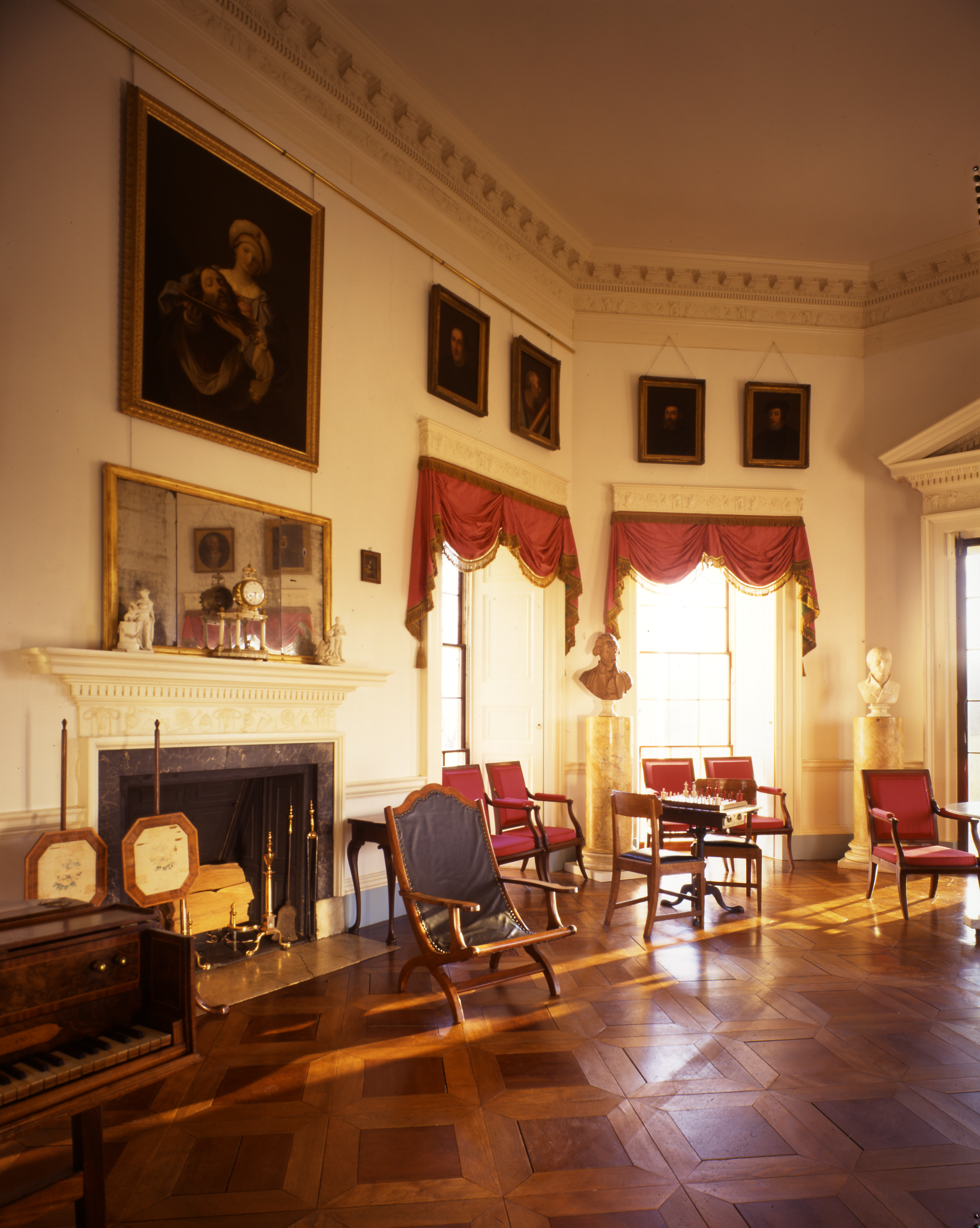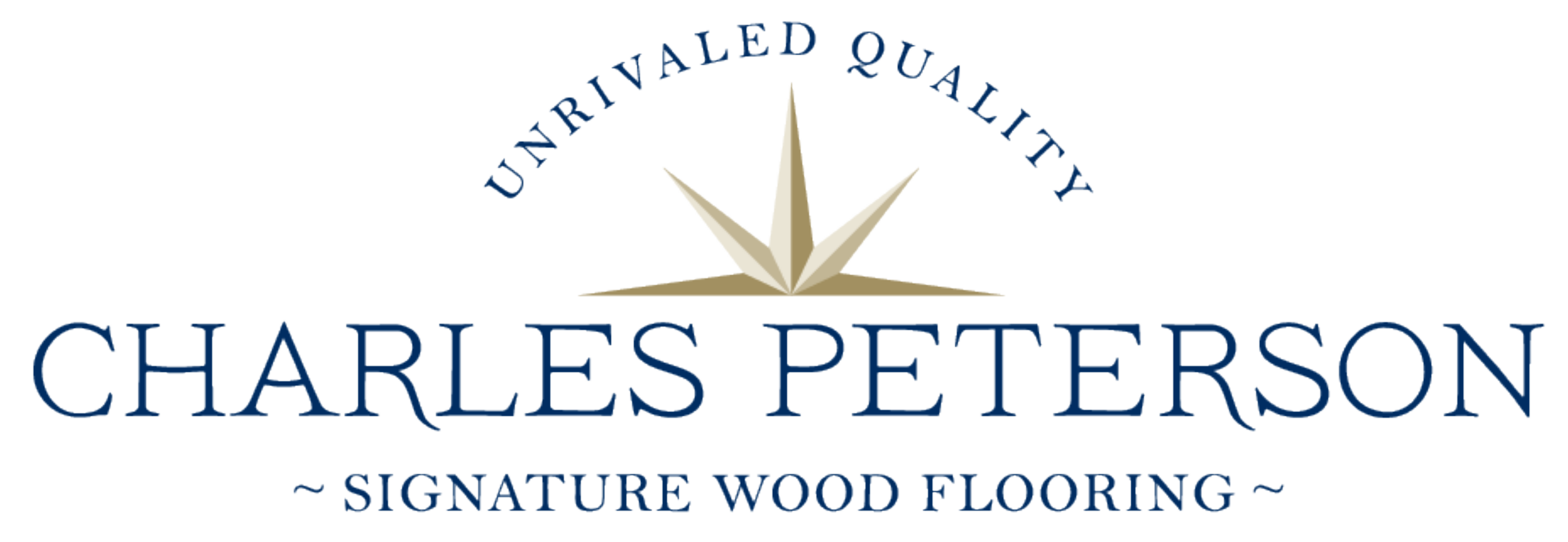
Historic floors have long been a neglected subject. floors have always been of a lower architectural hierarchy than other elements of a building, yet floors are expected to withstand centuries of wear, fire, and water damage. Conservators of historic buildings have started taking steps to preserve these fragile wood floors for posterity, but many historic wood floors have already been subjected to excessive deterioration.

Thomas Jefferson’s Monticello parquet pattern
The floor in Thomas Jefferson’s parlor was installed sometime around September 1804 – June 1805. The cherry panels are 12” square. The beech frame members are 4 1/4″ wide. The cherry panels are held into the frames with a tongue and groove joint on the sides’ perpendicular to the grain of the panels. On the other two sides, iron pins or dowels are used. The frames are joined at the corners using a mitered half-lap. Screws are inserted from the backside to hold these joints together. The original finish was probably oil and beeswax. Now, the floor is occasionally waxed and buffed, and any touchup is done with orange shellac.

Even in historic buildings that have preservation programs in place, the wood floors may not be regarded as significantly as other architectural elements. Several years ago, I toured the Biltmore Estate in Asheville, North Carolina. The Biltmore, built in 1895, is richly ornamented in the French renaissance style and is patterned after three early-16thcentury châteaux: the Blois, Clemenceau, and Chambord. an expert team of preservationists work there year-round. On my tour, I casually commented to an attendant that I believed a large area of floor had been repaired. Ten minutes later two men approached me. I tried to remember if I had walked into any restricted areas, but it turned out they just wanted to know how I could tell the floor had been repaired. To my eye, it was obvious. While they’d matched the finish well, the replacement wood was obviously new. Old wood tends to have much tighter grain, and the new boards they’d used showed wide growth rings and open grain that did not match the floors in other parts of the estate.
Clearly, replacing old floors isn’t that easy, so protecting and maintaining them is a major concern. You can minimize wear by limiting traffic or placing carpet runners in walking areas. Back in the day, historic wood floors may have been cleaned with beer or vinegar or by dry washing with slightly damp fuller’s earth, a fine claylike material, on the floor and dry scrubbing. Dry sweeping with herbs was also popular. The floors probably picked up some character from these cleaning techniques, but today one should use the least damaging methods to maintain the flooring. Use soft-bristle brooms or felt-lined vacuum attachments on old floors. Floors coated with varnish, shellac, or lacquer finish should nev-er be damp mopped. If need be, use a small amount of mineral spirits to remove surface stains. Time creates a priceless patina on the floors that is almost impossible to recreate. When possible, repair rather than replace historic wood flooring. I use historically appropriate methods when repairing old floors; for example, scraping worn finishes rather than sanding them. Don’t neglect the rest of the house when working on old floors. The walls and trim are historic, too, and need protection.
Replacing boards, when board replacement is unavoidable, duplicate the patina, wood grain, age, color, and texture as close as pos-sible. My grandfather, who was a genius at restoration, repeated these principles to me so many times that I hear them in my sleep. If the flooring is too severely deteriorated to be repaired, try to replace with boards taken from normally hidden areas such as under stairs or cabinets. Document changes well for future reference. not all historic buildings contain a supply of boards from inconspicuousplaces. Sometimes there placement must come from outside. If you do much historic preservation work, it’s a good idea to create a supply of aged boards. When the opportunity arises, I take them from old buildings that don’t have much significance or are being torn down. Sometimes you can find old wood in architectural salvage yards.

Old-growth eastern white pine was commonly used throughout the northeast and heart pine in the southern states. The eastern white pine is often referred to as pumpkin pine because it develops a warm amber patina over time. Lower grades of plank flooring were commonly used on the second floor of the home and in rooms of less importance. New lumber from tree plantations doesn’t come close to replicating the look or the hardness of this old-growth lumber. Some of the earliest softwood floors were uncoated. These bare wide planks were generally maintained by washing them with water and homemade lye. Over their life these floors may have been painted, finished with linseed oil, waxed, shellacked, or varnished (urethane is not varnish, though it’s often called that), and all these finishes can be replicated today. After grain, color can be the hardest thing to match. Some people try to age new boards with lime solutions or fuming them with ammonia, but it generally comes down to a good eye and a mixture of dyes and stains. Although modern stains and dyes are often used, a stain made from boiling walnut husks creates a lovely shade of deep golden brown. Historic floors take a lot of work and expertise. Without the expertise, you probably won’t be called on to work on significant buildings. But there’s still a lot of satisfaction in restoring a true colonial or Victorian floor to its original state. What else do most of us get to do in our lives that will go on serving its original purpose for the better part of another century?
A portion of all funds from historic preservation projects is donated to the Charles E Peterson fellowship trust fund. It is administered by The Athenaeum of Philadelphia exclusively for charitable and educational purposes which reflect Mr. Peterson’s life-long dedication to the study, recording, and preservation of early American architecture and building technology.

